Maintaining a healthy, green lawn is a top concern for many homeowners, and fertilization is key to achieving this. Like any living thing, your grass requires nutrients to grow and thrive. Fertilizers are specifically developed to replenish these nutrients. But it’s important to know when and how to fertilize your lawn to make the most of it.
When to Fertilize Your Lawn
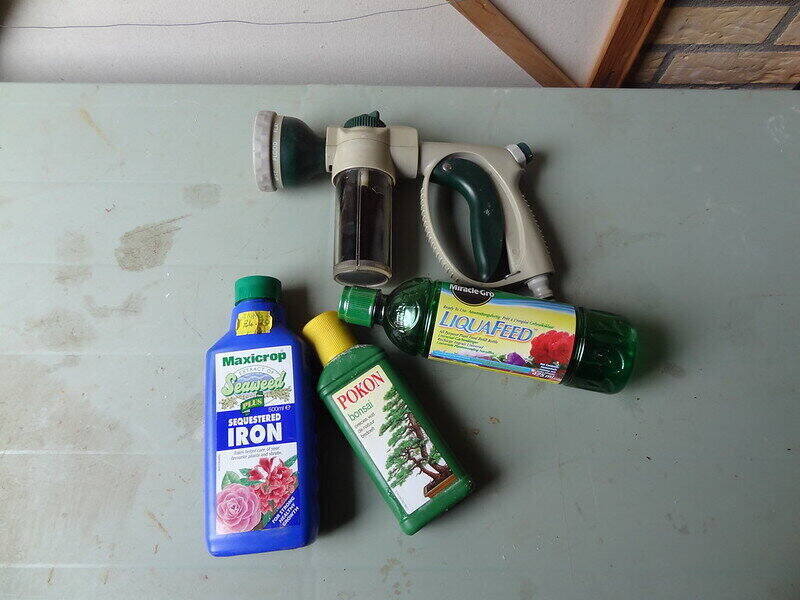
Photo Credit: Jerry Norbury / Flickr / CC BY-ND 2.0
When it comes to fertilizing your lawn, timing is everything. The answer to the “when” question depends on the following:
- Type of grass
- The climate of the area you live in
But there is one general rule: Don’t feed the lawn during periods of dormancy – only fertilize your grass at the time of year when it grows actively.
There are two types of grasses: warm-season grasses and cool-season grasses, and both have different growth and fertilization requirements. You have cool-season grass if you live in the northern third of the country and warm-season grass if you live in the southern third. If you live in the middle of the US, you may have either or both types of grass.
But what is the right time to fertilize either of them? Here is the answer:
When to Fertilize Cool-Season Grasses
Cool-season grasses like Kentucky bluegrass, tall fescue, and perennial ryegrass grow actively in cooler months. Usually, the grass grows most actively in fall, so the best time to fertilize your lawn is once in early fall and once in late fall, at least 6 weeks before the expected first frost. During these times, the grass is actively developing and can best use the fertilizer’s nutrients.
You can also apply fertilizer to your lawn in early spring because it’s the time when the grass greens up after winter dormancy and has a brief period of growth before the heat of summer sets in. It is the optimal time if you want to apply a third application of fertilizer to your lawn in addition to those done in fall.
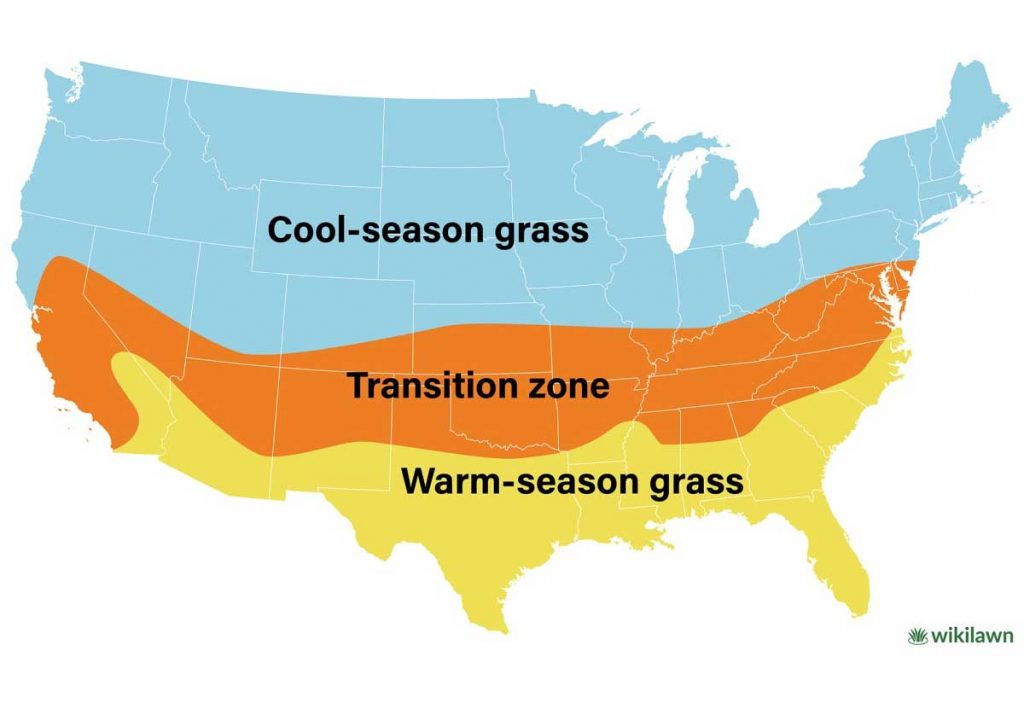
Illustration by Juan Rodriguez
When to Fertilize Warm-Season Grasses
On the other hand, warm-season grasses, such as Bermudagrass, St. Augustinegrass, or Zoysiagrass, have totally different fertilization times. Because they actively grow in the warmer months, late spring and early summer is usually the best time to apply fertilizer. This helps the grass to receive nutrients during its active development phase while remaining lush throughout the summer.
If you want a fall fertilizer application, early fall, at least 6-8 weeks before the first frost, is also suitable for your warm-season lawn.
You can read our guide to the ideal lawn fertilizer schedule to learn more about when to fertilize your lawn.
How Often to Apply Fertilizer to Your Lawn
Generally, apply fertilizer to your lawn two to four times per year. The frequency might vary depending on the type of grass, the makeup of your soil, the local climate of your area, and the type of fertilizer used. Slow-release fertilizers remain in the soil for 6-8 weeks, so you should wait at least 6 weeks between applications. Immediate-release fertilizers need to be applied more often to remain effective, about every 4-6 weeks.
The most common frequency recommendation for lawn fertilizer application is:
- Firstly, apply a slow-release fertilizer, irrespective of grass type, in early spring to promote growth and recovery from winter dormancy. But use a less nitrogen-heavy fertilizer for cool-season grass.
- A second fertilizer application is often recommended in late spring or early summer for warm-season grasses to maintain healthy growth and help the grass withstand stress from heat and foot traffic during the summer.
- Another round of fertilization in late summer or early fall helps to support the grass’s recovery from summer stress and prepares the lawn for the colder months ahead. This time requires a heavier application of fertilizer for cool-season grass and a lighter one for warm-season grass.
How to Apply Fertilizer to Your Lawn
Once you’re sure you’ve got the timing right, follow these steps to fertilize your lawn in the best and most efficient way possible.
Step 1: Prepare Your Lawn Before Fertilization
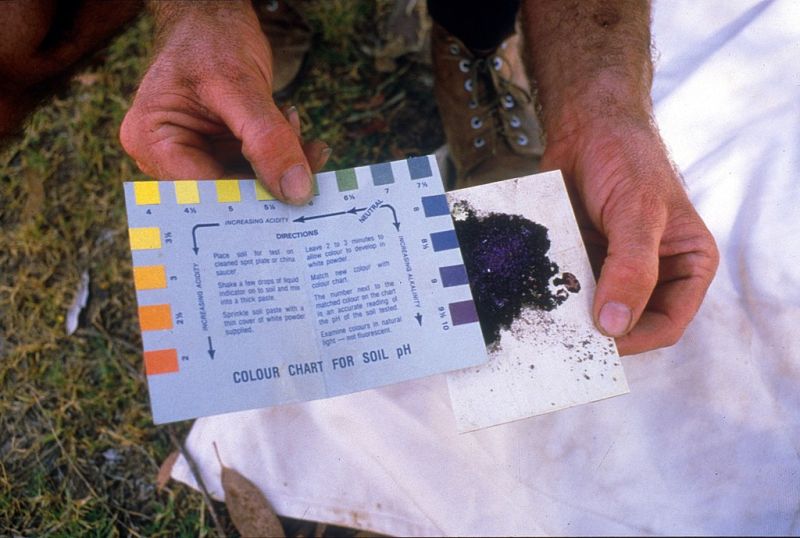
Photo Credit: CSIRO / Wikimedia Commons / CC BY 3.0
Before applying fertilizer to your lawn, you should do a few things to ensure the best results and minimize any potential harm to your grass or the environment. Preparing your lawn ahead of time will set up the foundation for successful fertilization.
- Get your soil tested and amend it accordingly.
Soil tests are like bloodwork for your soil. They describe the type of soil, the level of plant nutrients, and the soil pH, among other things. Get your soil tested by sending a sample to your local county Cooperative Extension office or buy an at-home test kit for quicker but less detailed results.
Based on the soil test results, amend your soil to make it adaptable for the turfgrass and fertilizer. Adjust the soil’s pH so that it’s between 6.5 to 7 (ideal for most grass types) by adding lime for lawns to increase the pH or sulfur to decrease the pH.
- Remove any obstacles blocking the soil.
Remove any lawn weeds, moss, or excessive thatch growth in your lawn before fertilizing. Obstacles like these can prevent fertilizer from reaching the soil, which is where it needs to be for your grass to absorb its nutrients.
- Mow to an ideal height.
Ideally, you should mow the grass slightly lower than its typical maintenance height before fertilizing. Shorter grass permits the fertilizer to reach the soil more effectively and reduces the possibility of the fertilizer sitting on top of tall blades and causing burn or uneven distribution.
- Water your lawn to attain sufficient soil moisture.
Water your lawn well for at least three to four days before fertilizing it. Moist soil improves nitrogen uptake and reduces the risk of fertilizer burn. Overwatering, on the other hand, can cause the fertilizer to seep away or become less effective.
Step 2: Apply the Fertilizer to Your Lawn
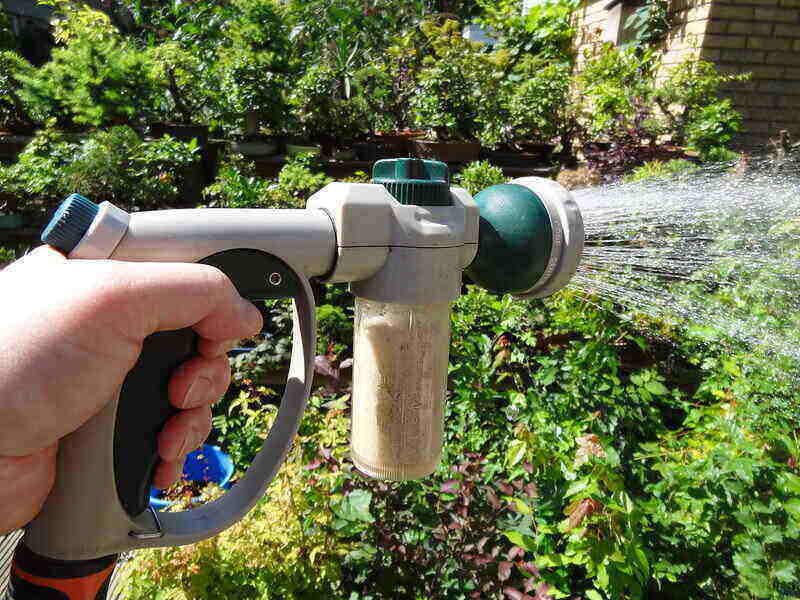
Photo Credit: Jerry Norbury / Flickr / CC BY-ND 2.0
It is essential to apply lawn fertilizer carefully to ensure nutrients reach the plant roots and deliver maximum benefits.
First, choose the right tool according to your lawn’s area and fertilizer type. There are various kinds of fertilizer spreaders, including:
- Broadcast Spreaders, or rotary spreaders, are the most popular and distribute granular fertilizer in a broad pattern, spreading it uniformly over your lawn. They have a rotating disc that disperses the fertilizer in a wide arc as the spreader is pushed or towed. They are suitable for applying fertilizer in a wide pattern and appropriate for more extensive areas.
- Drop Spreaders are designed to drop the fertilizer directly between the spreader’s wheels. Drop spreaders work best in smaller areas, especially when you want accurate fertilizer spread.
- Handheld Spreaders are small, handheld devices convenient for precise application in tight spaces or irregularly shaped areas.
- Tow-Behind Spreaders are attached to a garden tractor or riding mower and towed behind it. Because of the larger hopper capacity, these spreaders are ideal to use in larger commercial areas.
- Sprayers are mainly used to apply liquid fertilizers to your lawn.
Fill your chosen tool with fertilizer on a non-grassy, hard surface like a driveway or sidewalk. This keeps spills or excess fertilizer from reaching the grass before you begin, which again reduces the risk of fertilizer burn.
Start Applying the Fertilizer: Begin walking across your lawn at a slow, steady pace, pushing the spreader consistently. If you’re using a sprayer, spray a wide arc in front of you, from side to side, as you walk. Then turn around and walk the other way in a line parallel to your first pass. Continue walking back and forth across the lawn in parallel lines until you’ve covered the whole area.
To achieve thorough coverage and eliminate missed spots, overlap each pass slightly. If you’re using a granular fertilizer, check the grass for any prominent clumps or heaps of granules once you’ve finished applying it. Use a sweep or rake to disperse these clumps to ensure even dispersion.
Note: After each usage, properly clean your spreader or sprayer. Rinse it with water to remove any residual fertilizer, which can damage the equipment if not removed.
Step 3: Water Your Lawn Immediately After Fertilization
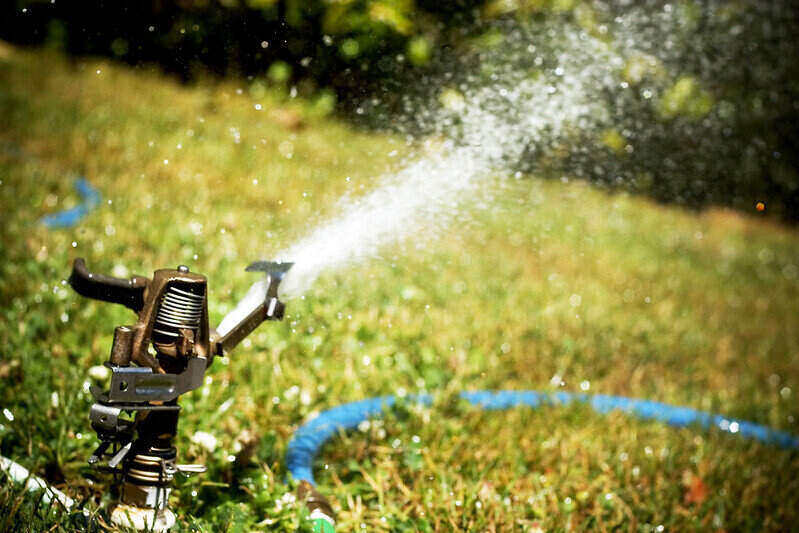
Photo Credit: Shaylor / Flickr / CC BY-ND 2.0
Watering your lawn after fertilizing is essential for activating the nutrients in the fertilizer and ensuring optimum absorption by the grass’s roots. It is best to water your grass immediately after fertilizing it. This reduces the risk of burn from concentrated nutrients lingering on the grass blades.
Use an in-ground sprinkler system or a hose with a sprinkler attachment for even coverage. To avoid overwatering certain areas and underwatering others, make sure the water is distributed evenly across the lawn.
Note: If you use liquid fertilizer, wait two to four hours for the fertilizer to dry, and then water your lawn. Don’t water immediately after applying liquid fertilizer because it will wash the fertilizer away before it’s had time to soak into the soil.
Step 4: Clean Up
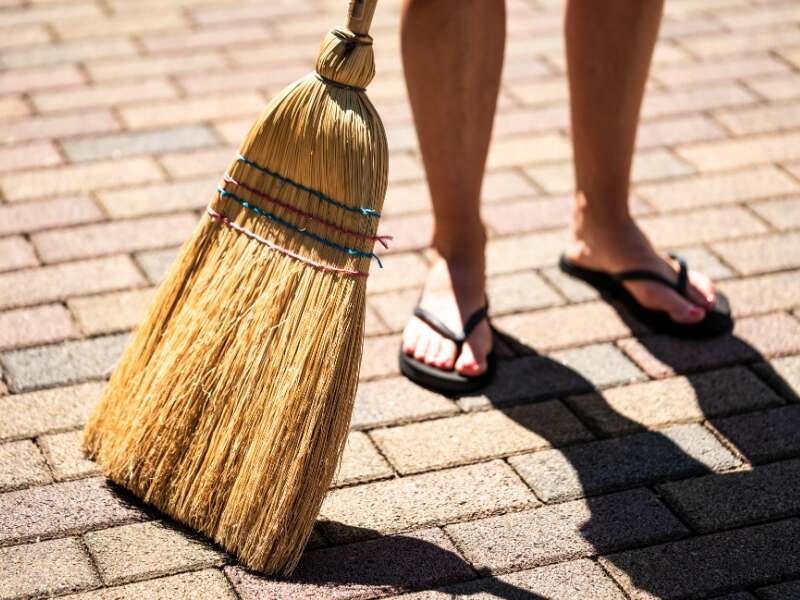
Photo Credit: undefined undefined / Canva Pro / License
In addition to cleaning your spreader or sprayer, it’s important to clean excess fertilizer off impervious surfaces near your grass, such as a driveway or patio. For granular fertilizers, sweep off any granules that may have landed on sidewalks or driveways to prevent runoff into nearby bodies of water. Fertilizer runoff can cause water pollution and harmful algae blooms.
Be especially diligent about sweeping up excess fertilizer if you have curious pets or small children in your family who might try to play with or even eat the tiny granules.
How to Select the Right Lawn Fertilizer
Choosing the right fertilizer for your lawn is critical. First of all, check your soil’s nutrient requirements through your soil test. Then select a fertilizer with a suitable nitrogen, potassium, and phosphorus ratio according to your soil’s needs.
In addition to finding a lawn fertilizer with the right nutrient blend, you’ll need to decide what type of fertilizer is best for your lawn. You’ll have to choose between slow-release and immediate-release fertilizers, synthetic and organic fertilizers, and liquid and granular fertilizers.
To learn more about each of these options and figure out which one is best for you, see our guide on How to Choose Lawn Fertilizer.
FAQ About Fertilizing the Lawn
Can I fertilize my grass using organic fertilizers?
Yes, organic fertilizers are an excellent choice for lawn care. They come from natural sources and provide slow-release nutrients that improve soil health and microbial activity. Organic fertilizers are less harmful to the environment and contribute towards eco-friendly lawn care.
Look for organic fertilizers designed exclusively for lawns in our guide to organic lawn fertilizer.
What should I do if I over-fertilize my lawn accidentally?
It’s critical to act quickly if you mistakenly over-fertilize. Thoroughly water the lawn to help dilute and flush out extra nitrogen and other nutrients. Mow as little as possible until the grass recovers, and consider skipping the next scheduled fertilization to let the grass rebalance. If extensive damage develops, such as the grass turning brown, your grass may be dead. Seek the advice of a lawn care specialist to figure out the best path forward.
Is it safe to fertilize my grass during the hot summer months?
It’s best to avoid fertilizing during periods of excessive heat or drought. High heat and dry weather can cause stress on the grass, and fertilization during this time may worsen the stress.
Final Thoughts
Regular fertilization not only improves the general health and appearance of your lawn, but it also increases its resistance to external stressors like severe temperatures and foot traffic. It’s an essential technique contributing to a beautiful, healthy lawn you can enjoy all year. For help keeping up with a regular fertilization schedule, connect with a local lawn care pro on WikiLawn today.
Main Photo Credit: SVproduction / Canva Pro / License

